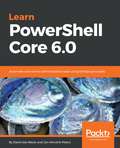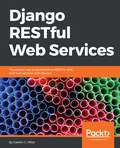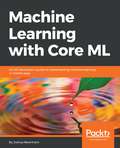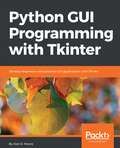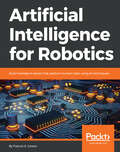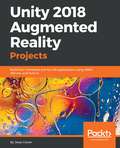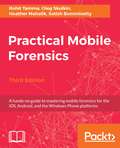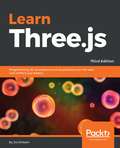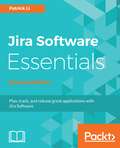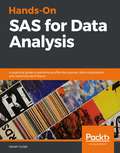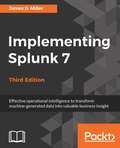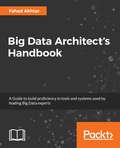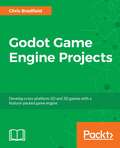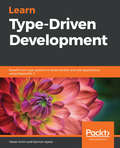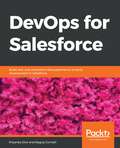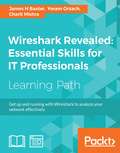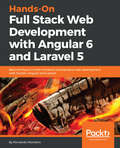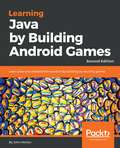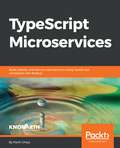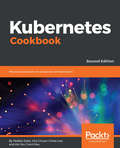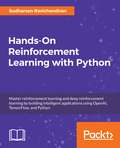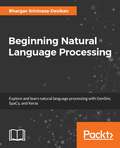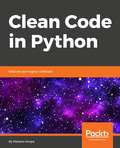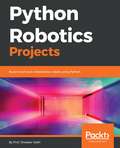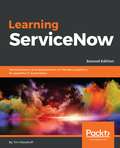- Table View
- List View
Learn PowerShell Core 6.0: Automate and control administrative tasks using DevOps principles
by David Das Neves Jan-Hendrik PetersEnhance your skills in expert module development, deployment, security, DevOps, and cloudKey FeaturesA step-by-step guide to get you started with PowerShell Core 6.0Harness the capabilities of PowerShell Core 6.0 to perform simple to complex administration tasksLearn core administrative concepts such as scripting, pipelines, and DSCBook DescriptionBeginning with an overview of the different versions of PowerShell, Learn PowerShell Core 6.0 introduces you to VSCode and then dives into helping you understand the basic techniques in PowerShell scripting. You will cover advanced coding techniques, learn how to write reusable code as well as store and load data with PowerShell.This book will help you understand PowerShell security and Just Enough Administration, enabling you to create your own PowerShell repository. The last set of chapters will guide you in setting up, configuring, and working with Release Pipelines in VSCode and VSTS, and help you understand PowerShell DSC. In addition to this, you will learn how to use PowerShell with Windows, Azure, Microsoft Online Services, SCCM, and SQL Server. The final chapter will provide you with some use cases and pro tips.By the end of this book, you will be able to create professional reusable code using security insight and knowledge of working with PowerShell Core 6.0 and its most important capabilities.What you will learnGet to grips with Powershell Core 6.0Explore basic and advanced PowerShell scripting techniquesGet to grips with Windows PowerShell SecurityWork with centralization and DevOps with PowerShellImplement PowerShell in your organization through real-life examplesLearn to create GUIs and use DSC in productionWho this book is forIf you are a Windows administrator or a DevOps user who wants to leverage PowerShell to automate simple to complex tasks, then this book is for you. Whether you know nothing about PowerShell or just enough to get by, this guide will give you what you need to go to take your scripting to the next level. You’ll also find this book useful if you’re a PowerShell expert looking to expand your knowledge in areas such as PowerShell Security and DevOps.
Django RESTful Web Services: The easiest way to build Python RESTful APIs and web services with Django
by Norbert Máté Gastón C. HillarDesign, build and test RESTful web services with the Django framework and Python Key Features Create efficient real-world RESTful web services with the latest Django framework Authenticate, secure, and integrate third-party packages efficiently in your Web Services Leverage the power of Python for faster Web Service development Book Description Django is a Python web framework that makes the web development process very easy. It reduces the amount of trivial code, which simplifies the creation of web applications and results in faster development. It is very powerful and a great choice for creating RESTful web services. If you are a Python developer and want to efficiently create RESTful web services with Django for your apps, then this is the right book for you. The book starts off by showing you how to install and configure the environment, required software, and tools to create RESTful web services with Django and the Django REST framework. We then move on to working with advanced serialization and migrations to interact with SQLite and non-SQL data sources. We will use the features included in the Django REST framework to improve our simple web service. Further, we will create API views to process diverse HTTP requests on objects, go through relationships and hyperlinked API management, and then discover the necessary steps to include security and permissions related to data models and APIs. We will also apply throttling rules and run tests to check that versioning works as expected. Next we will run automated tests to improve code coverage. By the end of the book, you will be able to build RESTful web services with Django. What you will learn The best way to build a RESTful Web Service or API with Django and the Django REST Framework Develop complex RESTful APIs from scratch with Django and the Django REST Framework Work with either SQL or NoSQL data sources Design RESTful Web Services based on application requirements Use third-party packages and extensions to perform common tasks Create automated tests for RESTful web services Debug, test, and profile RESTful web services with Django and the Django REST Framework Who this book is for This book is for Python developers who want to create RESTful web services with Django; you need to have a basic working knowledge of Django but no previous experience with RESTful web services is required.
Machine Learning with Core ML: An iOS developer's guide to implementing machine learning in mobile apps
by Joshua NewnhamLeverage the power of Apple's Core ML to create smart iOS appsKey Features Explore the concepts of machine learning and Apple’s Core ML APIs Use Core ML to understand and transform images and videos Exploit the power of using CNN and RNN in iOS applicationsBook DescriptionCore ML is a popular framework by Apple, with APIs designed to support various machine learning tasks. It allows you to train your machine learning models and then integrate them into your iOS apps.Machine Learning with Core ML is a fun and practical guide that not only demystifies Core ML but also sheds light on machine learning. In this book, you’ll walk through realistic and interesting examples of machine learning in the context of mobile platforms (specifically iOS). You’ll learn to implement Core ML for visual-based applications using the principles of transfer learning and neural networks. Having got to grips with the basics, you’ll discover a series of seven examples, each providing a new use-case that uncovers how machine learning can be applied along with the related concepts. By the end of the book, you will have the skills required to put machine learning to work in their own applications, using the Core ML APIsWhat you will learnUnderstand components of an ML project using algorithms, problems, and dataMaster Core ML by obtaining and importing machine learning model, and generate classesPrepare data for machine learning model and interpret results for optimized solutionsCreate and optimize custom layers for unsupported layers Apply CoreML to image and video data using CNNLearn the qualities of RNN to recognize sketches, and augment drawingUse Core ML transfer learning to execute style transfer on imagesWho this book is forMachine Learning with Core ML is for you if you are an intermediate iOS developer interested in applying machine learning to your mobile apps. This book is also for those who are machine learning developers or deep learning practitioners who want to bring the power of neural networks in their iOS apps. Some exposure to machine learning concepts would be beneficial but not essential, as this book acts as a launchpad into the world of machine learning for developers.
Python GUI Programming with Tkinter: Develop responsive and powerful GUI applications with Tkinter
by Alan D MooreFind out how to create visually stunning and feature-rich applications by empowering Python's built-in Tkinter GUI toolkitKey Features Explore Tkinter's powerful features to easily design and customize your GUI application Learn the basics of 2D and 3D animation in GUI applications. Learn to integrate stunning Data Visualizations using Tkinter Canvas and Matplotlib.Book DescriptionTkinter is a lightweight, portable, and easy-to-use graphical toolkit available in the Python Standard Library, widely used to build Python GUIs due to its simplicity and availability. This book teaches you to design and build graphical user interfaces that are functional, appealing, and user-friendly using the powerful combination of Python and Tkinter.After being introduced to Tkinter, you will be guided step-by-step through the application development process. Over the course of the book, your application will evolve from a simple data-entry form to a complex data management and visualization tool while maintaining a clean and robust design. In addition to building the GUI, you'll learn how to connect to external databases and network resources, test your code to avoid errors, and maximize performance using asynchronous programming. You'll make the most of Tkinter's cross-platform availability by learning how to maintain compatibility, mimic platform-native look and feel, and build executables for deployment across popular computing platforms.By the end of this book, you will have the skills and confidence to design and build powerful high-end GUI applications to solve real-world problems.What you will learn Implement the tools provided by Tkinter to design beautiful GUIs Discover cross-platform development through minor customizations in your existing application Visualize graphs in real time as data comes in using Tkinter's animation capabilities Use PostgreSQL authentication to ensure data security for your application Write unit tests to avoid regressions when updating codeWho this book is forThis book will appeal to developers and programmers who would like to build GUI-based applications. Knowledge of Python is a prerequisite.
Artificial Intelligence for Robotics: Build intelligent robots that perform human tasks using AI techniques
by Francis X. GoversBring a new degree of interconnectivity to your world by building your own intelligent robots Key Features Leverage fundamentals of AI and robotics Work through use cases to implement various machine learning algorithms Explore Natural Language Processing (NLP) concepts for efficient decision making in robots Book Description Artificial Intelligence for Robotics starts with an introduction to Robot Operating Systems (ROS), Python, robotic fundamentals, and the software and tools that are required to start out with robotics. You will learn robotics concepts that will be useful for making decisions, along with basic navigation skills. As you make your way through the chapters, you will learn about object recognition and genetic algorithms, which will teach your robot to identify and pick up an irregular object. With plenty of use cases throughout, you will explore natural language processing (NLP) and machine learning techniques to further enhance your robot. In the concluding chapters, you will learn about path planning and goal-oriented programming, which will help your robot prioritize tasks. By the end of this book, you will have learned to give your robot an artificial personality using simulated intelligence. What you will learn Get started with robotics and artificial intelligence Apply simulation techniques to give your robot an artificial personality Understand object recognition using neural networks and supervised learning techniques Pick up objects using genetic algorithms for manipulation Teach your robot to listen using NLP via an expert system Use machine learning and computer vision to teach your robot how to avoid obstacles Understand path planning, decision trees, and search algorithms in order to enhance your robot Who this book is for If you have basic knowledge about robotics and want to build or enhance your existing robot's intelligence, then Artificial Intelligence for Robotics is for you. This book is also for enthusiasts who want to gain knowledge of AI and robotics.
Unity 2018 Augmented Reality Projects: Build four immersive and fun AR applications using ARKit, ARCore, and Vuforia
by Jesse GloverCreate engaging Augmented Reality (AR) applications with Unity 3D that can be experienced with devices such as HoloLens and DaydreamKey FeaturesLearn the principles of AR application development Work with the most popular sensors used in AR games and applications across Android, Apple and WindowsBuild experiences with interactive objects, physics, UI, animations, and C# scriptingBook DescriptionAugmented Reality allows for radical innovations in countless areas. It magically blends the physical and virtual worlds, bringing applications from a screen into your hands. Meanwhile, Unity has now become the leading platform to develop augmented reality experiences, as it provides a great pipeline for working with 3D assets.Using a practical and project-based approach, Unity 2018 Augmented Reality Projects educates you about the specifics of augmented reality development in Unity 2018.This book teaches you how to use Unity in order to develop AR applications which can be experienced with devices such as HoloLens and Daydream. You will learn to integrate, animate, and overlay 3D objects on your camera feed, before gradually moving on to implementing sensor-based AR applications. In addition to this, you will explore the technical considerations that are especially important and possibly unique to AR. The projects in the book demonstrate how you can build a variety of AR experiences, whilst also giving insights into C# programming as well as the Unity 3D game engine via the interactive Unity Editor.By the end of the book, you will be equipped to develop rich, interactive augmented reality experiences for a range of AR devices and platforms using Unity.What you will learnBuild and run AR applications for specific headsets, including HoloLens and DaydreamCreate 3D scenes with Unity and other 3D tools while learning about world space and scaleMove around your AR scenes using locomotion and teleportationCreate filters or overlays that work in tandem with facial recognition softwareUse GPS, geolocation services, and the camera feed to create a fitness applicationIntegrate AR and VR concepts together in a single applicationWho this book is forUnity 2018 Augmented Reality Projects is for you if you're a game developer familiar with 3D computer graphics and interested in building your own AR games or applications. Any experience in Unity and C# is an advantage.
Practical Mobile Forensics,: A hands-on guide to mastering mobile forensics for the iOS, Android, and the Windows Phone platforms, 3rd Edition
by Rohit Tamma Heather Mahalik Satish Bommisetty Oleg Skulkin Igor MikhaylovInvestigate, analyze, and report iOS, Android, and Windows devices Key Features Get hands-on experience in performing simple to complex mobile forensics techniques. Retrieve and analyze data stored not only on mobile devices but also through the cloud and other connected mediums. A practical guide to leveraging the power of mobile forensics on popular mobile platforms with lots of tips, tricks, and caveats. Book Description Covering up-to-date mobile platforms, this book will focuses on teaching you the most recent techniques for investigating mobile devices. We delve mobile forensics techniques in iOS 9-11, Android 7-8 devices, and Windows 10. We will demonstrate the latest open source and commercial mobile forensics tools, enabling you to analyze and retrieve data effectively. You will learn how to introspect and retrieve data from the cloud, and document and prepare reports of your investigations. By the end of this book, you will have mastered the current operating systems and the relevant techniques to recover data from mobile devices by leveraging open source solutions. What you will learn Discover the new techniques in practical mobile forensics Understand the architecture and security mechanisms present in iOS and Android platforms Identify sensitive files on the iOS and Android platforms Set up a forensic environment Extract data from the iOS and Android platforms Recover data on the iOS and Android platforms Understand the forensics of Windows devices Explore various third-party application techniques and data recovery techniques Who this book is for If you are a forensics professional and are eager to widen your forensics skill set to mobile forensics then, this book is for you. Some understanding of digital forensics practices would do wonders.
Learn Three.js: Programming 3D animations and visualizations for the web with HTML5 and WebGL, 3rd Edition
by Jos DirksenCreate and animate stunning 3D browser based graphics with Three.js JavaScript libraryKey FeaturesEnhance your 3D graphics with light sources, shadows, advanced materials, and texturesLoad models from external sources, and visualize and animate them directly from JavaScriptCreate your own custom WebGL shader and explore the postprocessing feature of Three.jsBook DescriptionWebGL makes it possible to create 3D graphics in the browser without having to use plugins such as Flash and Java. Programming WebGL, however, is difficult and complex. With Three.js, it is possible to create stunning 3D graphics in an intuitive manner using JavaScript, without having to learn WebGL. With this book, you’ll learn how to create and animate beautiful looking 3D scenes directly in your browser-utilizing the full potential of WebGL and modern browsers. It starts with the basic concepts and building blocks used in Three.js. From there on, it will expand on these subjects using extensive examples and code samples. You will learn to create, or load, from externally created models, realistic looking 3D objects using materials and textures. You’ll find out how to easily control the camera using the Three.js built-in in camera controls, which will enable you to fly or walk around the 3D scene you created. You will then use the HTML5 video and canvas elements as a material for your 3D objects and to animate your models. Finally, you will learn to use morph and skeleton-based animation, and even how to add physics, such as gravity and collision detection, to your scene. After reading this book, you’ll know everything that is required to create 3D animated graphics using Three.js.What you will learnWork with the different types of materials in Three.js and see how they interact with your 3D objects and the rest of the environmentImplement the different camera controls provided by Three.js to effortlessly navigate around your 3D sceneWork with vertices directly to create snow, rain, and galaxy-like effectsImport and animate models from external formats, such as OBJ, STL, and COLLADACreate and run animations using morph targets and bones animationsExplore advanced textures on materials to create realistic looking 3D objects by using bump maps, normal maps, specular maps, and light mapsInteract directly with WebGL by creating custom vertex and fragment shadersWho this book is forThe ideal target audience for this book would be JavaScript developers who who want to learn how to use the Three.js library
Jira Software Essentials - Second Edition: Plan, track, and release great applications with Jira Software
by Patrick LiExplore Jira Software to manage your projects proficiently Key Features Plan and manage projects effortlessly with Jira Software by integrating it with other applications Improve your team's performance with Scrum and Kanban, together with agile methodology Easy-to-follow learning guide to install Jira Software and understand how it fits in with Atlassian Jira Book Description Jira Software is an agile project management tool that supports any agile methodology, be it scrum, Kanban, or your own unique flavour. From agile boards to reports, you can plan, track, and manage all your agile software development projects from a single tool. Jira Software brings the power of agile methodology to Atlassian Jira. This second edition of JIRA Agile Essentials, will help you dive straight into the action, exploring critical agile terminologies and concepts in the context of Jira Software. You will learn how to plan, track, and release great software. This book will teach you how to install and run Jira Software and set it up to run with Scrum and Kanban. It will also teach you to use Jira Software your way and run projects beyond the out-of-box Scrum and Kanban way, including a hybrid approach of both the methodologies and other options that come with Jira Software. Later, you will learn how to integrate it with the tools you are already using and enhance Jira with add-ons such as Confluence. You will learn to stay connected with your team from anywhere to ensure great development. Jira Software has numerous deployment options in the cloud, on your own infrastructure, or at a massive scale. You will be introduced to Bitbucket, Atlassian’s distributed version control system, which integrates seamlessly with Jira, allowing your team to work within the two applications as one harmonious environment. With this practical guide, you will develop a great working knowledge of Jira Software and your project management will become much more efficient. What you will learn Understand the basics and agile methodologies of Jira software Use Jira Software in a Scrum environment Manage and run Jira Software projects beyond the out of box Scrum and Kanban way Combine Scrum and Kanban and use other project management options beyond just agile Customize Jira Software’s various features and options as per your requirements Work with Jira Agile offline, and plan and forecast projects with agile portfolio Integrate Jira Agile with Confluence and Bitbucket Who this book is for If you want to get started with Jira Software and learn how to run your Jira projects the agile way, then this is the perfect book for you. You will need to be familiar with the basics of Jira, both from an end user's and an administrator's perspective. Experience with workflows, custom fields, and other administrative functions of Jira will be useful.
Hands-On SAS for Data Analysis: A practical guide to performing effective queries, data visualization, and reporting techniques
by Harish GulatiLeverage the full potential of SAS to get unique, actionable insights from your data Key Features Build enterprise-class data solutions using SAS and become well-versed in SAS programming Work with different data structures, and run SQL queries to manipulate your data Explore essential concepts and techniques with practical examples to confidently pass the SAS certification exam Book Description SAS is one of the leading enterprise tools in the world today when it comes to data management and analysis. It enables the fast and easy processing of data and helps you gain valuable business insights for effective decision-making. This book will serve as a comprehensive guide that will prepare you for the SAS certification exam. After a quick overview of the SAS architecture and components, the book will take you through the different approaches to importing and reading data from different sources using SAS. You will then cover SAS Base and 4GL, understanding data management and analysis, along with exploring SAS functions for data manipulation and transformation. Next, you'll discover SQL procedures and get up to speed on creating and validating queries. In the concluding chapters, you'll learn all about data visualization, right from creating bar charts and sample geographic maps through to assigning patterns and formats. In addition to this, the book will focus on macro programming and its advanced aspects. By the end of this book, you will be well versed in SAS programming and have the skills you need to easily handle and manage your data-related problems in SAS. What you will learn Explore a variety of SAS modules and packages for efficient data analysis Use SAS 4GL functions to manipulate, merge, sort, and transform data Gain useful insights into advanced PROC SQL options in SAS to interact with data Get to grips with SAS Macro and define your own macros to share data Discover the different graphical libraries to shape and visualize data with Apply the SAS Output Delivery System to prepare detailed reports Who this book is for Budding or experienced data professionals who want to get started with SAS will benefit from this book. Those looking to prepare for the SAS certification exam will also find this book to be a useful resource. Some understanding of basic data management concepts will help you get the most out of this book.
Implementing Splunk 7, Third Edition: Effective Operational Intelligence To Transform Machine-generated Data Into Valuable Business Insight, 3rd Edition
by James D. MillerThis book will help you implement Splunk 7's new services and will show you how to utilize them to quickly and efficiently process machine-generated big data. You will explore Splunk Cloud and the Machine Learning Toolkit and use them with ease throughout your organization. By the end of the book, you will have learned to implement these services in your tasks at work.
Big Data Architect’s Handbook: A guide to building proficiency in tools and systems used by leading big data experts
by Syed Muhammad AkhtarA comprehensive end-to-end guide that gives hands-on practice in big data and Artificial IntelligenceKey FeaturesLearn to build and run a big data application with sample codeExplore examples to implement activities that a big data architect performsUse Machine Learning and AI for structured and unstructured dataBook DescriptionThe big data architects are the “masters” of data, and hold high value in today’s market. Handling big data, be it of good or bad quality, is not an easy task. The prime job for any big data architect is to build an end-to-end big data solution that integrates data from different sources and analyzes it to find useful, hidden insights.Big Data Architect’s Handbook takes you through developing a complete, end-to-end big data pipeline, which will lay the foundation for you and provide the necessary knowledge required to be an architect in big data. Right from understanding the design considerations to implementing a solid, efficient, and scalable data pipeline, this book walks you through all the essential aspects of big data. It also gives you an overview of how you can leverage the power of various big data tools such as Apache Hadoop and ElasticSearch in order to bring them together and build an efficient big data solution.By the end of this book, you will be able to build your own design system which integrates, maintains, visualizes, and monitors your data. In addition, you will have a smooth design flow in each process, putting insights in action.What you will learn Learn Hadoop Ecosystem and Apache projects Understand, compare NoSQL database and essential software architecture Cloud infrastructure design considerations for big data Explore application scenario of big data tools for daily activities Learn to analyze and visualize results to uncover valuable insights Build and run a big data application with sample code from end to end Apply Machine Learning and AI to perform big data intelligence Practice the daily activities performed by big data architectsWho this book is forBig Data Architect’s Handbook is for you if you are an aspiring data professional, developer, or IT enthusiast who aims to be an all-round architect in big data. This book is your one-stop solution to enhance your knowledge and carry out easy to complex activities required to become a big data architect.
Godot Engine Game Development Projects: Build five cross-platform 2D and 3D games with Godot 3.0
by Chris BradfieldA project based guides to learn animation, advanced shaders, environments, particle rendering, and networked games with Godot 3.0Key FeaturesLearn the art of developing cross-platform gamesLeverage Godot’s node and scene system to design robust, reusable game objectsIntegrate Blender easily and efficiently with Godot to create powerful 3D gamesBook DescriptionGodot Engine Game Development Projects is an introduction to the Godot game engine and its new 3.0 version. Godot 3.0 brings a large number of new features and capabilities that make it a strong alternative to expensive commercial game engines. For beginners, Godot offers a friendly way to learn game development techniques, while for experienced developers it is a powerful, customizable tool that can bring your visions to life.This book consists of five projects that will help developers achieve a sound understanding of the engine when it comes to building games.Game development is complex and involves a wide spectrum of knowledge and skills. This book can help you build on your foundation level skills by showing you how to create a number of small-scale game projects. Along the way, you will learn how Godot works and discover important game development techniques that you can apply to your projects.Using a straightforward, step-by-step approach and practical examples, the book will take you from the absolute basics through to sophisticated game physics, animations, and other techniques. Upon completing the final project, you will have a strong foundation for future success with Godot 3.0.What you will learnGet started with the Godot game engine and editorOrganize a game projectImport graphical and audio assetsUse Godot’s node and scene system to design robust, reusable game objectsWrite code in GDScript to capture input and build complex behaviorsImplement user interfaces to display informationCreate visual effects to spice up your gameLearn techniques that you can apply to your own game projectsWho this book is forGodot Engine Game Development Projects is for both new users and experienced developers, who want to learn to make games using a modern game engine. Some prior programming experience in C and C++ is recommended.
Learn Type Driven Development: Benefit from type systems to build reliable and safe applications using ReasonML 3
by Yawar AminProgrammers coming from dynamically-typed languages who have felt the pain of production bugs and are looking for ways to mitigate them, and programmers from statically-typed languages looking for more safety and performance techniques, and possibly for a better experience with a statically-typed language.
DevOps for Salesforce: Build, test, and streamline data pipelines to simplify development in Salesforce
by Priyanka Dive Nagraj GornalliImplement DevOps for Salesforce and explore its featuresKey FeaturesLearn DevOps principles and techniques for enterprise operations in SalesforceImplement Continuous Integration and Continuous Delivery using tools such as Jenkins and Ant scriptUse the Force.com Migration Tool and Git to achieve versioning in SalesforceBook DescriptionSalesforce is one of the top CRM tools used these days, and with its immense functionalities and features, it eases the functioning of an enterprise in various areas of sales, marketing, and finance, among others. Deploying Salesforce applications is a tricky event, and it can get quite taxing for admins and consultants. This book addresses all the problems that you might encounter while trying to deploy your applications and shows you how to resort to DevOps to take these challenges head on.Beginning with an overview of the development and delivery process of a Salesforce app, DevOps for Salesforce covers various types of sandboxing and helps you understand when to choose which type. You will then see how different it is to deploy with Salesforce as compared to deploying with another app. You will learn how to leverage a migration tool and automate deployment using the latest and most popular tools in the ecosystem. This book explores topics such as version control and DevOps techniques such as Continuous Integration, Continuous Delivery, and testing. Finally, the book will conclude by showing you how to track bugs in your application changes using monitoring tools and how to quantify your productivity and ROI.By the end of the book, you will have acquired skills to create, test, and effectively deploy your applications by leveraging the features of DevOps.What you will learnImplement DevOps for Salesforce and understand the benefits it offersAbstract the features of Force.com MigrationTool to migrate and retrieve metadataDevelop your own CI/CD Pipeline for Salesforce projectUse Qualitia to perform scriptless automation for Continuous TestingTrack application changes using BugzillaApply Salesforce best practices to implement DevOpsWho this book is forIf you are a Salesforce developer, consultant, or manager who wants to learn DevOps tools and set up pipelines for small as well as large Salesforce projects, this book is for you.
Wireshark Revealed: Essential Skills for IT Professionals
by James H Baxter Yoram Orzach Charit MishraMaster Wireshark and discover how to analyze network packets and protocols effectively, along with engaging recipes to troubleshoot network problems About This Book • Gain valuable insights into the network and application protocols, and the key fields in each protocol • Use Wireshark's powerful statistical tools to analyze your network and leverage its expert system to pinpoint network problems • Master Wireshark and train it as your network sniffer Who This Book Is For This book is aimed at IT professionals who want to develop or enhance their packet analysis skills. A basic familiarity with common network and application services terms and technologies is assumed. What You Will Learn • Discover how packet analysts view networks and the role of protocols at the packet level • Capture and isolate all the right packets to perform a thorough analysis using Wireshark's extensive capture and display filtering capabilities • Decrypt encrypted wireless traffic • Use Wireshark as a diagnostic tool and also for network security analysis to keep track of malware • Find and resolve problems due to bandwidth, throughput, and packet loss • Identify and locate faults in communication applications including HTTP, FTP, mail, and various other applications – Microsoft OS problems, databases, voice, and video over IP • Identify and locate faults in detecting security failures and security breaches in the network In Detail This Learning Path starts off installing Wireshark, before gradually taking you through your first packet capture, identifying and filtering out just the packets of interest, and saving them to a new file for later analysis. You will then discover different ways to create and use capture and display filters. By halfway through the book, you'll be mastering Wireshark features, analyzing different layers of the network protocol, and looking for any anomalies.We then start Ethernet and LAN switching, through IP, and then move on to TCP/UDP with a focus on TCP performance problems. It also focuses on WLAN security. Then, we go through application behavior issues including HTTP, mail, DNS, and other common protocols. This book finishes with a look at network forensics and how to locate security problems that might harm the network.This course provides you with highly practical content explaining Metasploit from the following books: 1) Wireshark Essentials 2) Network Analysis Using Wireshark Cookbook 3) Mastering Wireshark Style and approach This step-by-step guide follows a practical approach, starting from the basic to the advanced aspects. Through a series of real-world examples, this learning path will focus on making it easy for you to become an expert at using Wireshark.
Hands-On Full Stack Web Development with Angular 6 and Laravel 5: Become fluent in both frontend and backend web development with Docker, Angular and Laravel
by Fernando MonteiroBuild modern, fast, and progressive web applications using modern features of PHP 7 and TypeScriptKey FeaturesExplore the latest features of Angular and Laravel to build applications that are powerful, consistent, and maintainableDevelop modern user interfaces with a reusable component-based architecture using Angular 6 and Bootstrap 4Learn how to build secure backend APIs with LaravelBook DescriptionAngular, considered as one of the most popular and powerful frontend frameworks, has undergone a major overhaul to embrace emerging web technologies so that developers can build cutting-edge web applications.This book gives you practical knowledge of building modern full-stack web apps from scratch using Angular with a Laravel Restful back end.The book begins with a thorough introduction to Laravel and Angular and its core concepts like custom errors messages, components, routers, and Angular-cli, with each concept being explained first, and then put into practice in the case-study project.With the basics covered, you will learn how sophisticated UI features can be added using NgBootstrao and a component-based architecture. You will learn to extend and customize variables from Bootstrap CSS framework.You will learn how to create secure web application with Angular and Laravel using token based authentication. Finally, you will learn all about progressive web applications and build and deploy a complete fullstack application using Docker and Docker-compose.By the end of this book, you'll gain a solid understanding of Angular 6 and how it interacts with a Laravel 5.x backendWhat you will learnExplore the core features of Angular 6 to create sophisticated user interfacesUse Laravel 5 to its full extent to create a versatile backend layer based on RESTful APIsConfigure a web application in order to accept user-defined data and persist it into the database using server-side APIsBuild an off-line-first application using service-worker and manifest fileDeal with token based authentication on single page application (SPA).Secure your application against threats and vulnerabilities in a time efficient wayDeploy using Docker and Docker-composeWho this book is forThis book targets developers who are new to Angular, Laravel, or both, and are seeking a practical, best-practice approach to development with these technologies. They must have some knowledge of HTML, CSS and JavaScript. Familiarity of PHP is assumed to get the most from this book.
Learning Java by Building Android Games: Learn Java and Android from scratch by building six exciting games, 2nd Edition
by John HortonGet ready for a fun-filled experience of learning Java by developing games for the Android platformKey FeaturesLearn Java, Android, and object-oriented programming from scratchBuild games including Sub Hunter, Retro Pong, Bullet Hell, Classic Snake, and a 2D Scrolling ShooterCreate and design your own games, such as an open-world platform gameBook DescriptionAndroid is one of the most popular mobile operating systems presently. It uses the most popular programming language, Java, as the primary language for building apps of all types. However, this book is unlike other Android books in that it doesn’t assume that you already have Java proficiency.This new and expanded second edition of Learning Java by Building Android Games shows you how to start building Android games from scratch. The difficulty level will grow steadily as you explore key Java topics, such as variables, loops, methods, object oriented programming, and design patterns, including code and examples that are written for Java 9 and Android P. At each stage, you will put what you’ve learned into practice by developing a game. You will build games such as Minesweeper, Retro Pong, Bullet Hell, and Classic Snake and Scrolling Shooter games. In the later chapters, you will create a time-trial, open-world platform game. By the end of the book, you will not only have grasped Java and Android but will also have developed six cool games for the Android platform.What you will learnSet up a game development environment in Android StudioImplement screen locking, screen rotation, pixel graphics, and play sound effectsRespond to a player’s touch, and program intelligent enemies who challenge the player in different waysLearn game development concepts, such as collision detection, animating sprite sheets, simple tracking and following, AI, parallax backgrounds, and particle explosionsAnimate objects at 60 frames per second (FPS) and manage multiple independent objects using Object-Oriented Programming (OOP)Understand the essentials of game programming, such as design patterns, object-oriented programming, Singleton, strategy, and entity-component patternsLearn how to use the Android API, including Activity lifecycle, detecting version number, SoundPool API, Paint, Canvas, and Bitmap classes Build a side-scrolling shooter and an open world 2D platformer using advanced OOP concepts and programming patternsWho this book is forLearning Java by Building Android Games is for you if you are completely new to Java, Android, or game programming and want to make Android games. This book also acts as a refresher for those who already have experience of using Java on Android or any other platform without game development experience.
TypeScript Microservices: Build, deploy, and secure Microservices using TypeScript combined with Node.js
by Parth GhiyaBuild robust microservice-based applications that are distributed, fault tolerant, and always availableKey FeaturesLearn to build message-driven services for effective communicationDesign microservices API using Reactive programming design patternsDeploy, scale and monitor microservices for consistent high performanceBook DescriptionIn the last few years or so, microservices have achieved the rock star status and right now are one of the most tangible solutions in enterprises to make quick, effective, and scalable applications. The apparent rise of Typescript and long evolution from ES5 to ES6 has seen lots of big companies move to ES6 stack. If you want to learn how to leverage the power of microservices to build robust architecture using reactive programming and Typescript in Node.js, then this book is for you.Typescript Microservices is an end-to-end guide that shows you the implementation of microservices from scratch; right from starting the project to hardening and securing your services. We will begin with a brief introduction to microservices before learning to break your monolith applications into microservices. From here, you will learn reactive programming patterns and how to build APIs for microservices. The next set of topics will take you through the microservice architecture with TypeScript and communication between services. Further, you will learn to test and deploy your TypeScript microservices using the latest tools and implement continuous integration. Finally, you will learn to secure and harden your microservice.By the end of the book, you will be able to build production-ready, scalable, and maintainable microservices using Node.js and Typescript.What you will learnGet acquainted with the fundamentals behind microservices.Explore the behavioral changes needed for moving from monolithic to microservices.Dive into reactive programming, Typescript and Node.js to learn its fundamentals in microservicesUnderstand and design a service gateway and service registry for your microservices.Maintain the state of microservice and handle dependencies.Perfect your microservice with unit testing and Integration testingDevelop a microservice, secure it, deploy it, and then scale itWho this book is forThis book is for JavaScript developers seeking to utilize their Node.js and Typescript skills to build microservices and move away from the monolithic architecture. Prior knowledge of TypeScript and Node.js is assumed.
Kubernetes Cookbook: Practical solutions to container orchestration, 2nd Edition
by Hui-Chuan Chloe Lee Ke-Jou Carol Hsu Hideto SaitoLearn how to automate and manage your containers and reduce the overall operation burden on your system.Key FeaturesUse containers to manage, scale and orchestrate apps in your organizationTransform the latest concept of Kubernetes 1.10 into examplesExpert techniques for orchestrating containers effectivelyBook DescriptionKubernetes is an open source orchestration platform to manage containers in a cluster environment. With Kubernetes, you can configure and deploy containerized applications easily. This book gives you a quick brush up on how Kubernetes works with containers, and an overview of main Kubernetes concepts, such as Pods, Deployments, Services and etc. This book explains how to create Kubernetes clusters and run applications with proper authentication and authorization configurations. With real-world recipes, you'll learn how to create high availability Kubernetes clusters on AWS, GCP and in on-premise datacenters with proper logging and monitoring setup. You'll also learn some useful tips about how to build a continuous delivery pipeline for your application. Upon completion of this book, you will be able to use Kubernetes in production and will have a better understanding of how to manage containers using Kubernetes.What you will learnBuild your own container clusterDeploy and manage highly scalable, containerized applications with KubernetesBuild high-availability Kubernetes clustersBuild a continuous delivery pipeline for your applicationTrack metrics and logs for every container running in your clusterStreamline the way you deploy and manage your applications with large-scale container orchestrationWho this book is forThis book is for system administrators, developers, DevOps engineers, or any stakeholder who wants to understand how Kubernetes works using a recipe-based approach. Basic knowledge of Kubernetes and Containers is required.
Hands-On Reinforcement Learning with Python: Master reinforcement and deep reinforcement learning using OpenAI Gym and TensorFlow
by Sudharsan RavichandiranA hands-on guide enriched with examples to master deep reinforcement learning algorithms with PythonKey FeaturesYour entry point into the world of artificial intelligence using the power of PythonAn example-rich guide to master various RL and DRL algorithmsExplore various state-of-the-art architectures along with mathBook DescriptionReinforcement Learning (RL) is the trending and most promising branch of artificial intelligence. Hands-On Reinforcement learning with Python will help you master not only the basic reinforcement learning algorithms but also the advanced deep reinforcement learning algorithms.The book starts with an introduction to Reinforcement Learning followed by OpenAI Gym, and TensorFlow. You will then explore various RL algorithms and concepts, such as Markov Decision Process, Monte Carlo methods, and dynamic programming, including value and policy iteration. This example-rich guide will introduce you to deep reinforcement learning algorithms, such as Dueling DQN, DRQN, A3C, PPO, and TRPO. You will also learn about imagination-augmented agents, learning from human preference, DQfD, HER, and many more of the recent advancements in reinforcement learning.By the end of the book, you will have all the knowledge and experience needed to implement reinforcement learning and deep reinforcement learning in your projects, and you will be all set to enter the world of artificial intelligence.What you will learnUnderstand the basics of reinforcement learning methods, algorithms, and elementsTrain an agent to walk using OpenAI Gym and TensorflowUnderstand the Markov Decision Process, Bellman’s optimality, and TD learningSolve multi-armed-bandit problems using various algorithmsMaster deep learning algorithms, such as RNN, LSTM, and CNN with applicationsBuild intelligent agents using the DRQN algorithm to play the Doom gameTeach agents to play the Lunar Lander game using DDPGTrain an agent to win a car racing game using dueling DQNWho this book is forIf you’re a machine learning developer or deep learning enthusiast interested in artificial intelligence and want to learn about reinforcement learning from scratch, this book is for you. Some knowledge of linear algebra, calculus, and the Python programming language will help you understand the concepts covered in this book.
Natural Language Processing and Computational Linguistics: A practical guide to text analysis with Python, Gensim, spaCy, and Keras
by Bhargav Srinivasa-DesikanWork with Python and powerful open source tools such as Gensim and spaCy to perform modern text analysis, natural language processing, and computational linguistics algorithms.Key FeaturesDiscover the open source Python text analysis ecosystem, using spaCy, Gensim, scikit-learn, and KerasHands-on text analysis with Python, featuring natural language processing and computational linguistics algorithmsLearn deep learning techniques for text analysisBook DescriptionModern text analysis is now very accessible using Python and open source tools, so discover how you can now perform modern text analysis in this era of textual data.This book shows you how to use natural language processing, and computational linguistics algorithms, to make inferences and gain insights about data you have. These algorithms are based on statistical machine learning and artificial intelligence techniques. The tools to work with these algorithms are available to you right now - with Python, and tools like Gensim and spaCy.You'll start by learning about data cleaning, and then how to perform computational linguistics from first concepts. You're then ready to explore the more sophisticated areas of statistical NLP and deep learning using Python, with realistic language and text samples. You'll learn to tag, parse, and model text using the best tools. You'll gain hands-on knowledge of the best frameworks to use, and you'll know when to choose a tool like Gensim for topic models, and when to work with Keras for deep learning.This book balances theory and practical hands-on examples, so you can learn about and conduct your own natural language processing projects and computational linguistics. You'll discover the rich ecosystem of Python tools you have available to conduct NLP - and enter the interesting world of modern text analysis.What you will learn Why text analysis is important in our modern age Understand NLP terminology and get to know the Python tools and datasetsLearn how to pre-process and clean textual dataConvert textual data into vector space representationsUsing spaCy to process text Train your own NLP models for computational linguisticsUse statistical learning and Topic Modeling algorithms for text, using Gensim and scikit-learnEmploy deep learning techniques for text analysis using KerasWho this book is forThis book is for you if you want to dive in, hands-first, into the interesting world of text analysis and NLP, and you're ready to work with the rich Python ecosystem of tools and datasets waiting for you!
Clean Code in Python: Refactor your legacy code base
by Mariano AnayaGetting the most out of Python to improve your codebaseKey FeaturesSave maintenance costs by learning to fix your legacy codebaseLearn the principles and techniques of refactoringApply microservices to your legacy systems by implementing practical techniquesBook DescriptionPython is currently used in many different areas such as software construction, systems administration, and data processing. In all of these areas, experienced professionals can find examples of inefficiency, problems, and other perils, as a result of bad code. After reading this book, readers will understand these problems, and more importantly, how to correct them. The book begins by describing the basic elements of writing clean code and how it plays an important role in Python programming. You will learn about writing efficient and readable code using the Python standard library and best practices for software design. You will learn to implement the SOLID principles in Python and use decorators to improve your code. The book delves more deeply into object oriented programming in Python and shows you how to use objects with descriptors and generators. It will also show you the design principles of software testing and how to resolve software problems by implementing design patterns in your code. In the final chapter we break down a monolithic application to a microservice one, starting from the code as the basis for a solid platform. By the end of the book, you will be proficient in applying industry approved coding practices to design clean, sustainable and readable Python code. What you will learnSet up tools to effectively work in a development environmentExplore how the magic methods of Python can help us write better codeExamine the traits of Python to create advanced object-oriented designUnderstand removal of duplicated code using decorators and descriptorsEffectively refactor code with the help of unit testsLearn to implement the SOLID principles in PythonWho this book is forThis book will appeal to team leads, software architects and senior software engineers who would like to work on their legacy systems to save cost and improve efficiency. A strong understanding of Programming is assumed.
Python Robotics Projects: Build smart and collaborative robots using Python
by Diwakar VaishLeverage the power of Python to build DIY robotic projectsKey FeaturesDesign, build, and stimulate collaborative robotsBuild high-end robotics projects such as a customized personal JarvisLeverage the power of Python and ROS for DIY robotic projectsBook DescriptionRobotics is a fast-growing industry. Multiple surveys state that investment in the field has increased tenfold in the last 6 years, and is set to become a $100-billion sector by 2020. Robots are prevalent throughout all industries, and they are all set to be a part of our domestic lives. This book starts with the installation and basic steps in configuring a robotic controller. You'll then move on to setting up your environment to use Python with the robotic controller. You'll dive deep into building simple robotic projects, such as a pet-feeding robot, and more complicated projects, such as machine learning enabled home automation system (Jarvis), vision processing based robots and a self-driven robotic vehicle using Python. By the end of this book, you'll know how to build smart robots using Python.What you will learn Get to know the basics of robotics and its functions Walk through interface components with microcontrollers Integrate robotics with the IoT environment Build projects using machine learning Implement path planning and vision processing Interface your robots with BluetoothWho this book is forIf building robots is your dream, then this book is made for you. Prior knowledge of Python would be an added advantage.
Learning ServiceNow: Administration and development on the Now platform, for powerful IT automation, 2nd Edition
by Tim WoodruffIT service management automation at your fingertipsKey FeaturesLearn to leverage ServiceNow’s capabilities for improved IT automation by following step-by-step, practical instructionsBuild core administration, development, and maintenance skills with IT service management in ServiceNowImprove your workflow efficiency by designing and creating responsive and automated workflows, business logic, and front-end automationBook DescriptionThis book is an updated version of Learning ServiceNow, that will cover the new and updated features of the ServiceNow platform. It will show you how to put important ServiceNow features to work in the real world, while introducing key concepts via examples of managing and automating IT services. It'll help you build a solid foundation of knowledge, and will demonstrate how to effectively implement and configure modules within ServiceNow. We'll show you how to configure and administer your instance, and then move on to building strong user interfaces and creating powerful workflows.We also cover other key elements of ServiceNow, such as notifications, security, reporting, and custom development. You will learn how to improve and automate your business' workflow and processes. By the end of this book, you will be able to successfully configure and manage ServiceNow like a pro.What you will learnRead and write clear, effective code for the ServiceNow platformIdentify and avoid common pitfalls and missteps that could seriously impact future progress and upgradeability Use debugging tools to troubleshoot when things go wrongDiscover tips and tricks from top ServiceNow developers, architects, and administrators. Find out what the pros wish they knew when they were starting outWho this book is forThis book is for IT professionals and administrators who are planning to or are already trying to implement ServiceNow in their organization for Enterprise IT service management tasks.Some familiarity with web technologies (JavaScript) would be helpful. Prior ServiceNow experience is not necessary.
